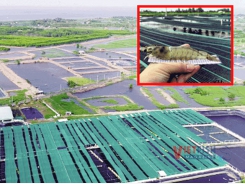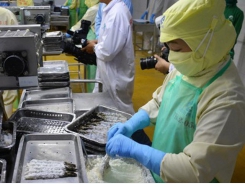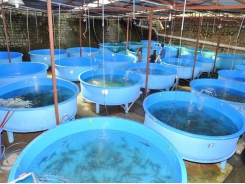Study: Fish fed yeast had better growth performance and feeding behaviour in fresh

Adding yeast as a protein to salmon feeds may improve fish growth, production and feed intake even during the transition from freshwater to saltwater environments, researchers say.
Candida utilis yeast is a promising protein source with functional properties in diets for smolting Atlantic salmon before and after seawater transfer (SWT), finds an international team of researchers from Chile and Norway.
They explored the use of that yeast type as a supplement in diets for Atlantic salmon during SWT and the influence of the yeast on growth performance and health.
“The objective of the present study was to investigate potential functional feed effects of moderate dietary levels of Candida utilis on Atlantic salmon growth rate, intestinal morphology, cytokine secretion, and transcriptional levels of genes involved in intestinal homeostasis and immune responses during the stressful SWT period,” the researchers said.
They found the salmon receiving the yeast-supplemented diets during both the freshwater (FW) and saltwater (SW) periods of production had higher feed intake and an improved growth rate compared to fish on the control diet.
Fish on the control diet had decreased intestinal fold length and a reduced number of CD3 cells in the folds of the distal intestine, they said. However, fish on the supplemented diet did not display similar changes.
Yeast-inclusive diets lowered the production of INFy, TNFa, IL-1B, IL-8 and “modulated the gene expression of aquaporin 8, superoxide dismutase (sod1) and major histocompatibility complex 1 (mhc1)” in the distal intestine (DI), they said. Those changes suggest a reduction in inflammation.
“The potential beneficial effects of yeast merit further investigation towards specific nutritional programming and lower inclusion levels of yeast to improve health and robustness during SWT,” the researchers said. “Overall, the study suggests that yeast is a high-quality protein source with beneficial health properties in diets for smoltifying Atlantic salmon.”
Freshwater, saltwater transition
Atlantic salmon is the primary species raised in Norwegian aquaculture and navigates a series of functional, structural and physiological changes as it transitions from freshwater (FW) to saltwater (SW), wrote the authors.
During the transition period, fish can be more sensitive to stress, infectious disease and damage. The seawater transfer (SWT) and initial months at sea can be a time of high mortality and economic loss for producers.
“Current disease control strategies in aquaculture include the use of chemotherapeutics, vaccination and selective breeding programs,” the researchers said. “These measures may decrease smoltification stress, but additional action is required to increase salmon smolt robustness during SWT. The use of functional ingredients in fish feeds and adapted feeding protocols are a possible solution to these challenges.”
Why add yeast to salmon diets?
The rapid growth in the aquaculture industry, but stable production of the main protein source, fishmeal (FM), has led to the increasing use of alternatives, resulting in significant changes in the composition of aquafeeds.
Microbial ingredients such as bacterial meal and yeast represent potential sustainable alternative protein sources in aquafeeds due to their high nutritional value, in addition to their content of a wide range of bioactive components with potential as functional ingredients. wrote the authors.
"Feed ingredients are considered functional when they have health beneficial properties beyond their nutritional value (Montalban-Arques et al., 2015). The use of functional feeds to modulate the immune system has received increasing attention in fish farming (Herman and Schmidt, 2016; Kiron, 2012)."
The positive effects of yeast or its components have been documented in several studies for salmonids (Øverland and Skrede, 2017), they noted.
However, the authors pointed out that yeast strain, processing technology, and inclusion level can result in varying effects on the immune system (Hauptman et al., 2014; Øverland and Skrede, 2017).
They said that yeast produced from lignocellulosic biomass is a high-quality protein source with beneficial effects on fish health (Grammes et al., 2013).
When fish is fed a potential challenging plant-based diets combined with exposure to other stressors such as sub-optimal environmental condition (Mosberian-Tanha et al., 2018) or SWT, this could lead to adverse effects on intestinal function and an intensified immune response, wrote the team.
"Yeast contains a wide range of components such as α-glucan, β-glucan, α-mannan, nucleic acids (known as microbe-associated molecular patterns; MAMPs) and antioxidants (damage-associated molecular patterns; DAMPs) (Navarrete and Tovar-Ramírez, 2014).
"The immune modulation functions of glucans have been demonstrated at transcriptional and protein level in salmonids, mainly the expression of pro-inflammatory cytokines such as TNFα, IL-8 or IL-1β (Morales-Lange et al., 2015; Salah et al., 2017). The latter compounds can strengthen the gut barrier of fish, improve immune status and increase resistance to infectious pathogens (Meena et al., 2013)."
In this study they said the aim was to evaluate the immunomodulatory effect of yeast under two challenging conditions - SWT and plant-based diets, with the hypothesis that the inclusion of Candida utilis yeast in fish diets had the potential to enhance immunity and alleviate stress related to smoltification and SWT.
Feed trial details
During the feeding trial, 480 salmon pre-smolts received one of four combinations of feed and environment for a 56-day period, the researchers said. The feeds used were either a plant-based control diet or that diet with 25% yeast.
The diets and environment condition changes included a control diet provided fish in freshwater (FW) and seawater (SW) (control); the control diet provided to fish in FW and a yeast-based diet in SW (control/yeast); yeast-based diet in FW and SW (yeast); or a yeast-based diet in FW and the control diet in SW (yeast/control), they said. Fish were in FW from day 0 through day 28 of the trial and in SW from day 28 through day 56.
Sample fish were collected on days 0, 14, 28, 42 and 56 and total fish biomass per tank was noted on days 0, 28 and 56, they said.
Distal intestine (DI) samples were gathered for histology and immunohistochemistry analysis and DI, spleen and head kidney samples were used for gene and protein expression examinations.
Results
No mortalities were observed during either the FW or SW portion of the feeding trial, the researchers said.
Feed intake fell for fish on both diets during the SW phase, they said. However, fish on the yeast-supplemented diet during FW and SW production had higher weight gain and better feed intake.
“These findings indicate that Candida utilis yeast is a promising alternative protein source with functional properties in diets for smolting Atlantic salmon before and after SWT,” they said.
Fish presented normal morphology during FW and SW periods and no changes were noted by diet, they said. However, at the end of the SW period, the length of simple folds in the DI remained consistent for fish on the all yeast diet but declined in fish receiving only the control diet.
At day 28, the presence of CD3 T cells was similar for fish on both the control diet and yeast-supplemented diet, however by day 42 fish on the control diet had reduced levels of CD3 cells, the researchers added.
“Two weeks after SWT coupled with a shift in diet, a difference in CD3 labeled cells between the fish that changed diet from control to yeast (Control/Yeast) and the fish that changed from yeast to control (Yeast/Control) was observed,” they added.
Fish receiving only feed with yeast had increased expression of aquaporin 8, while levels of superoxide dismutase (sod1) fell as did amounts of the pro-inflammatory marker interleukin 1 beta (il1b), they said. Supplemented fish saw an upregulation in major histocompatibility complex 1 (mhc1) during the FW period.
“There was a significantly decreased protein level of IFNγ, TNFα, IL-1β, IL-8 and in DI of fish fed yeast compared to control,” they said. “No significant changes were observed in the protein level of any of the cytokines evaluated in head kidney or spleen.”
Source: Aquaculture
Authors: C. Sahlmann, B. Djordjevica, L. Lagos, L. Mydland, B. Morales-Lange, J. Hansen, R. Ånestad, L. Mercado, M. Bjelanovic, C. Press, M. Øverland
Related news
Tools

Phối trộn thức ăn chăn nuôi

Pha dung dịch thủy canh

Định mức cho tôm ăn

Phối trộn phân bón NPK

Xác định tỷ lệ tôm sống

Chuyển đổi đơn vị phân bón

Xác định công suất sục khí

Chuyển đổi đơn vị tôm

Tính diện tích nhà kính

Tính thể tích ao




 Fluctuations in the market, Pangasius exports struggle to…
Fluctuations in the market, Pangasius exports struggle to…  How to tackle mycotoxins in aquafeeds
How to tackle mycotoxins in aquafeeds